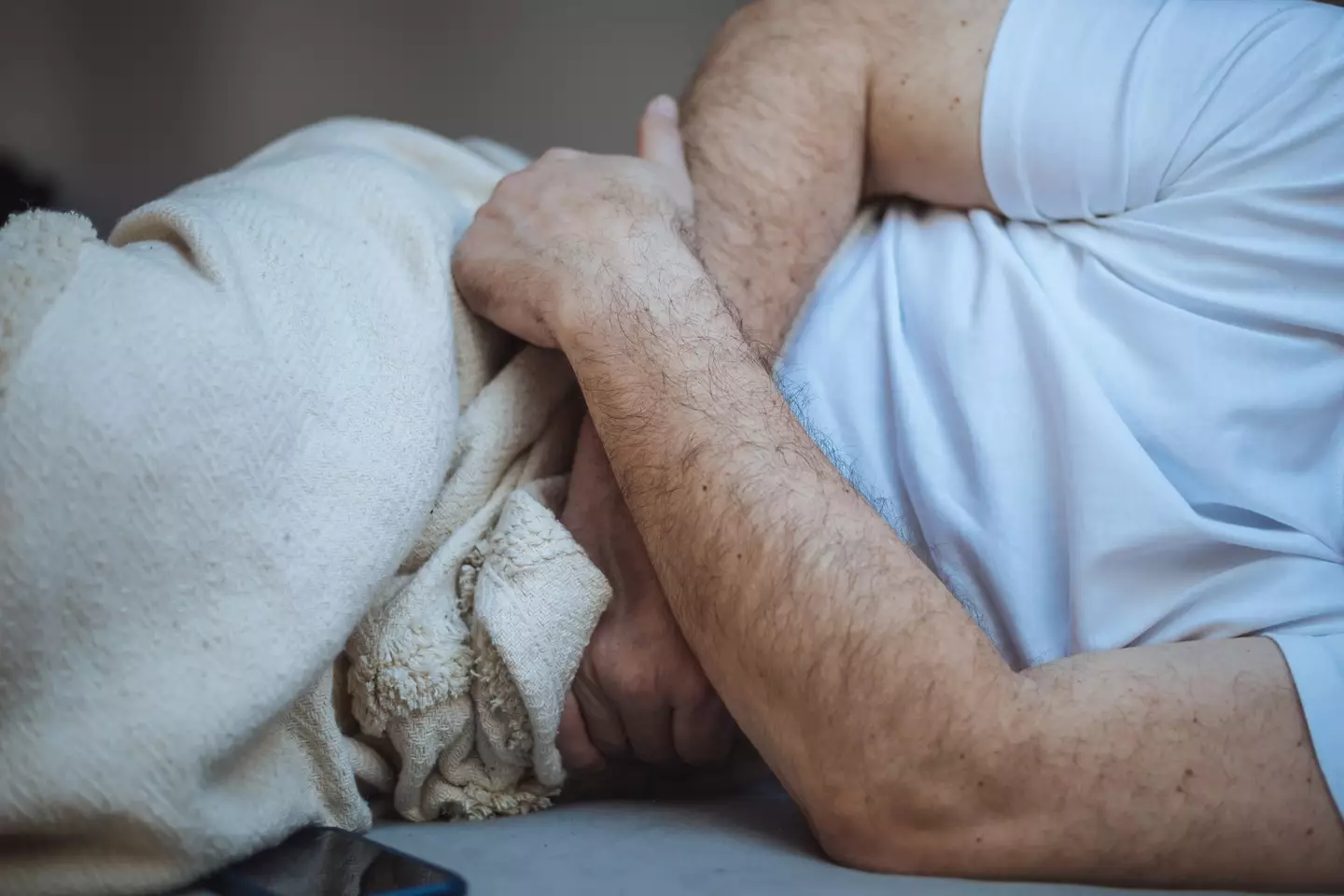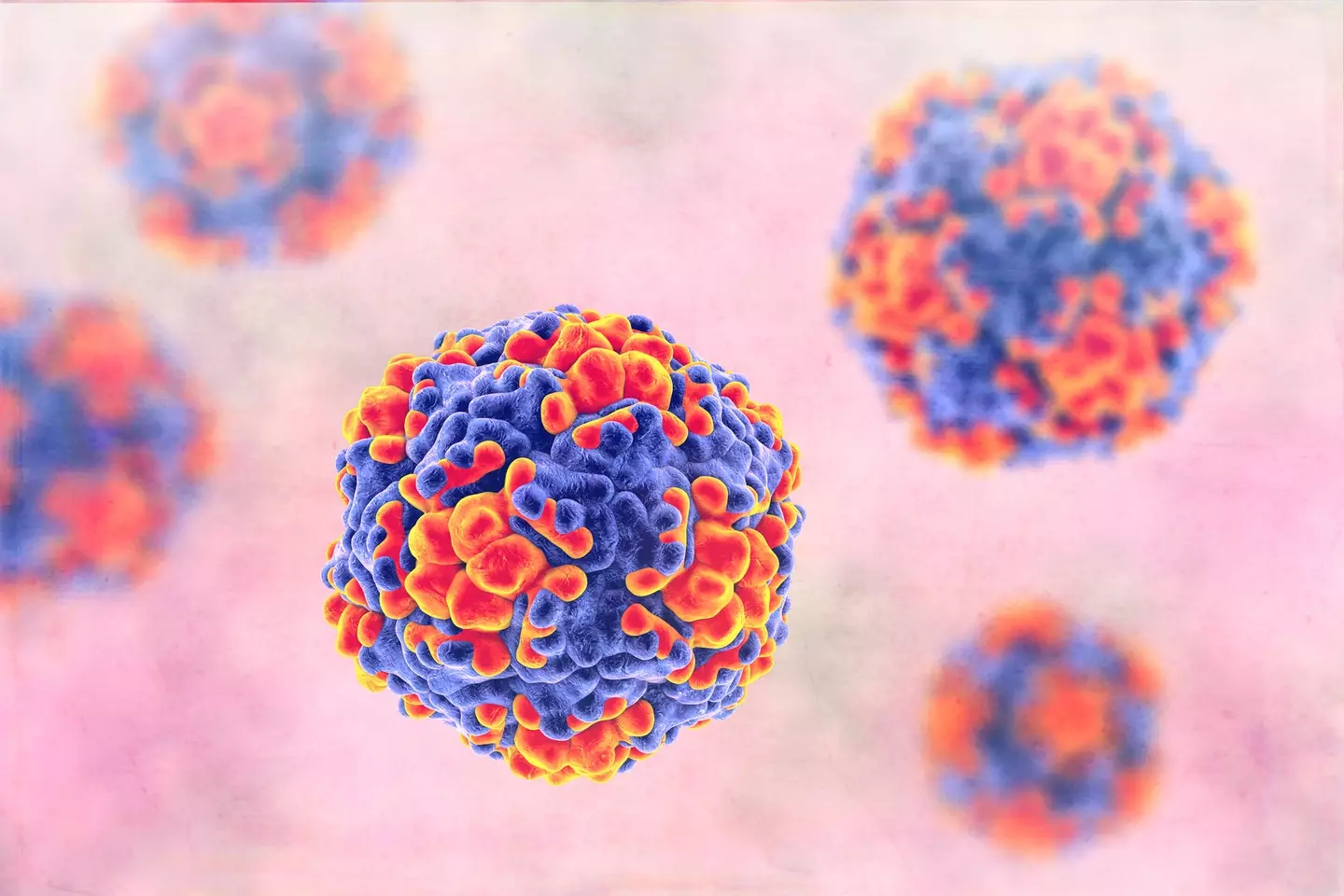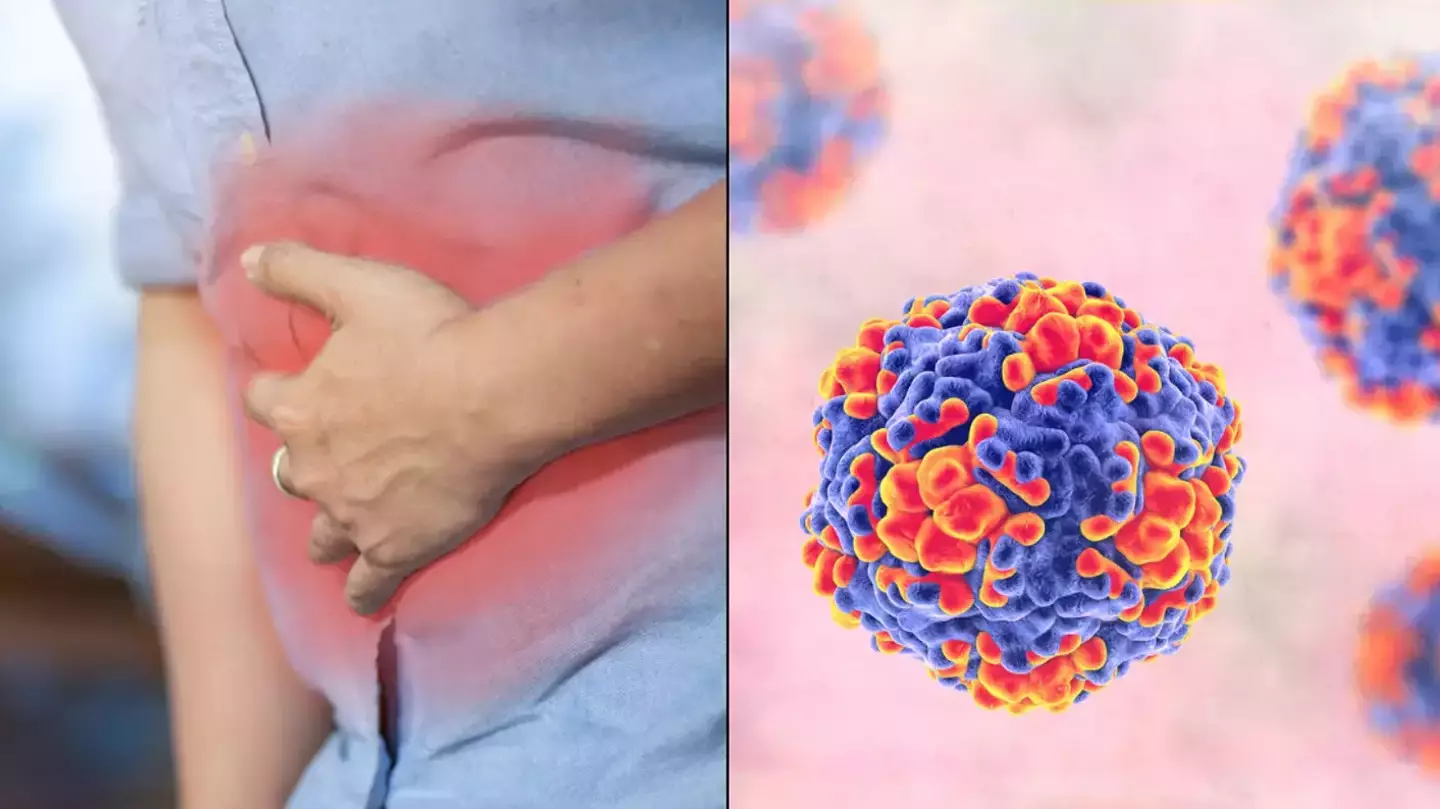From flu, to colds, covid and sick bugs, the winter months often brings an increase in nasty viruses.

There’s been a surge in cases of norovirus (Getty Stock Photo)
Now, the UK Health Security Agency has issued a warning after a surge in cases of the highly contagious Norovirus.
Norovirus, which has also been nicknamed the ‘winter vomiting bug’, is a virus that mainly causes vomiting and diarrhoea.
Sufferers may also have a fever, a headache and muscle aches, too.
If you’ve had it, you’ll know it’s pretty unpleasant, but it does often clear within a few days.
Norovirus is very contagious and is spread via close contact, surfaces, or by eating food that’s been prepared by someone with the bug.
So, if you do have it, it’s essential to stay at home and rest until it passes.

It’s best to stay at home if you come down with the illness (Getty Stock Photo)
Over the last couple of weeks, there’s been a surge in cases in the UK, of the GII.17 strain, which is responsible for the majority of bouts of the illness in Britain.
In fact, between 4-17 November, there was a 31.6 percent increase compared to the previous fortnight.
A report by the UKHSA claimed that the virus is ‘now increasing again across all age groups, with the biggest increase in adults, particularly adults aged 65 years and over’.
Reports indicate that total cases were almost double the five-season average for the same two-week period.
The report adds that there are ‘multiple factors [that] contributed to the observed increase in laboratory reports, such as ongoing changes to the epidemiology following the COVID-19 pandemic or changes in testing and reporting to national surveillance’.

The bug is highly contagious (Getty Stock Photo)
Amy Douglas, epidemiologist at UKHSA, said: “We continue to see high levels of Norovirus circulating in our communities. If you’ve caught the virus, take steps to avoid passing the infection on.
“If you have diarrhoea or vomiting, do not return to work, school or nursery until 48 hours after your symptoms have stopped and don’t prepare food for others in that time either.
“If you are unwell, avoid visiting people in hospitals and care homes to prevent passing on the infection in these settings.
“Washing your hands with soap and warm water and using bleach-based products to clean surfaces will also help stop infections from spreading. Alcohol gels do not kill Norovirus, so don’t rely on these alone.”
Featured Image Credit: Getty Stock Images

An ‘extremely contagious’ virus appears to be sweeping the UK at the moments as Brits are being urged to stay at home if they have these six symptoms.
Technically, it’s not even winter yet and it looks like the ‘winter vomiting bug’ has arrived early.
The truth is that you can get it at any time of the year, but it’s more common in winter.

There are a rise in cases (Getty Stock Images)
What is norovirus?
What we’re talking about here is norovirus, which is an ‘extremely contagious virus that spreads through contact and can cause sickness and diarrhoea for those infected’.
“Often referred to as the ‘winter vomiting bug’ cases of Norovirus soar over autumn and winter as more people spend time indoors, in close proximity to each other,” Dr John Burke, chief medical officer at AXA Health, said.
While symptoms can be pretty rough, norovirus remains as one of the most common stomach bugs in the UK.
Norovirus symptoms

Experts have encouraged you stay at home if you have these symptoms (Getty Stock Images)
As reported by the Metro, you need to look out for these six symptoms:
Nausea
Vomiting
Diarrhoea
High temperature
Headaches
Exhaustion
Norovirus treatment
Health experts suggest avoiding contact with others for at least 48 hours until your symptoms improve.
Staying at home when you’re ill, in general, is a good way to stop the spread of any virus.
I just got flashbacks from lockdown, so we’re just going to leave that one there.
“Try to keep your meals bland while you’re unwell with norovirus, to avoid further upsetting your stomach,” Dr Burke advised.
“If you are struggling to keep food down, try small amounts of easily digestible foods such as toast and crackers.

‘Rest is essential for a quick recovery’ (Getty Stock Images)
“With any illness that causes sickness, it’s really important to maintain fluid levels while unwell to prevent dehydration.
“Our bodies lose a lot of fluids through vomiting and diarrhoea therefore, you must be regularly drinking clear fluids and electrolytes when you are unwell with norovirus.
“When infected with norovirus, rest is essential for a quick recovery. It’s best to ensure that you are giving your body adequate time (a minimum of 48 hours) to rest and recover from the virus before returning back to work or school.”
Norovirus cases are rising
Amy Douglas, epidemiologist at UKHSA, explained: “The half-term school break is likely to have interrupted the upward trend we’ve been seeing recently in norovirus levels, but cases are likely to rise again as we head towards Christmas.”
She added: “Washing your hands with soap and warm water and using bleach-based products to clean surfaces will also help stop infections from spreading.”
Featured Image Credit: Getty Stock Images

A travel warning has been issued after heavy snow has fallen overnight in some areas in the UK.
The Met Office has given three yellow weather alerts for snow and ice across the Midlands, northern England, parts of Northern Ireland, north east Wales and sections of Northern Ireland.
Yellow warnings suggest that the weather is likely to ’cause some low level impacts, including some disruption to travel in a few places’.
This comes after National Rail said it would expect the cold climate to impact various routes until 2pm on Tuesday (19 November).

Travellers have been told to plan ahead this morning (Getty Stock Images)
These routes include Bradford Interchange and Huddersfield, and also between Halifax and Hebden Bridge and Hull.
Mersey Rail also said that its first lines would run without travellers to ensure safety.
Those who will be travelling this morning have been asked to plan their journey ahead by checking their local rail app or social media.
Dan Suri, Chief Meteorologist at the Met Office, said: “An area of low pressure slides its way eastwards on Monday night. The associated frontal system, marking the boundary between cold air in the north and milder conditions to the south, will bring disruptive snow to some areas between Monday evening and Tuesday morning.

The Met Office has issued three yellow weather alerts for snow and ice (BEN STANSALL/AFP via Getty Images)
“This is likely to coincide with rush hour, leading to disruption to some transport routes across a central swathe of the UK on Tuesday morning. It will also be windy in the far south.”
Across the North East and North West of the country, motorists have been advised to take extra care when heading out this morning.
Impacted roads included the M26 between J21-J23, the M1 at Leeds and Sheffield and the M56 at Manchester.
UK Health Security Agency (UKHSA) has since issued an amber warning, which covers the east and north of England, midlands, and Yorkshire and the Humber, with yellow alerts coming into place for the South East, South West and London at 8am on Tuesday, lasting until 6pm on Saturday.

There are likely to be some travel disruptions (Getty Stock Images)
Dr Agostinho Sousa, from the UKHSA, said: “This is the first amber Cold Weather Health Alert of the season.
“But we can expect more as we approach winter, and it is vital to check in on vulnerable friends, family and neighbours to ensure they are well prepared for the onset of cold weather.
“Particularly if they are elderly or otherwise at increased risk.”
Charity Age UK also warned that the conditions could be dangerous for vulnerable and elderly people.
Age UK director Caroline Abrahams said: “With high energy bills and food prices it is understandable that some may think they have to cut back on food and turn their heating off, but prolonged exposure to cold temperatures can have a serious impact on an older person’s health, especially if they are already trying to manage existing illnesses.”
Featured Image Credit: Getty Stock Images

A warning has been sent out to men across the country about their next visit to the barbers.
There aren’t many better feelings than getting a fresh trim, cleaning up the messy sides you’ve neglected for weeks and sporting that popular fade.
It’s been the ‘in’ hairstyle for years now, regardless of how long the hair on the top of your head is – but it turns out that getting skin fades in particular could put you at risk of a specific health issue.

Skin fades are causing the rise in cases of this health issue (Getty Stock Photo)
Cases of ringworm have increased drastically across the UK, and it’s said to be down to ‘cheap, dirty unqualified barbershops’.
It’s crucial that foil clippers used for skin fades are ‘thoroughly cleaned’, says Mike Taylor, who runs a barber training academy in Poole, Dorset.
The process takes about 10 minutes as they need to be disinfected, but Taylor believes that some barbers are skipping this step and has called on the government to put some new rules in place.
As a result, an increasing number of young men are catching ringworm from these uncleaned foil clippers.
What is ringworm?
The NHS describe ringworm as a ‘common fungal infection’ that isn’t ’caused by worms’, with medicines from a pharmacy usually being enough to treat it.
Not caused by actual worms, its main symptom is a rash, which may look red or darker than your regular skin, dependant on your tone.
The rash can be dry, itchy, scaly or swollen, and though it can appear anywhere, the type being talking about by Taylor is on the scalp, known scientifically as tinea capitis.
A pharmacist can usually recommend a type of tablet, cream, gel or spray to treat the rash, and they will tell you if you should see a GP.

A ringworm rash looks something like this (Getty Stock Photo)
How can ringworm be passed on?
As it is a type of fungi, it can be passed through close contact, either with an infected person or animal, objects and surfaces, or infected soil – the least common way of ringworm passing.
Why is ringworm a worry?
Speaking to the BBC, Taylor explained: “The high street is depleting, it’s dying and then suddenly there’s 12 barber shops on the same street and they’re all trying to go a little bit cheaper than each other.
“If the prices have to be knocked down then something else has to go and maybe it is all the time spent cleaning the equipment or the time spent getting the proper knowledge. Sometimes the cheapest price isn’t always the best price,” he highlighted.
He isn’t the only one that feels that rules should be changed though, as Gareth Penn, the registrar at the Hair and Barber Council, mentioned the need of a ‘mandatory register for those who wish to trade as hairdressers or barbers.’
The Hampshire-based council is a statutory authority for hairdressing in the UK, though it is only a voluntary register, the BBC reports.

An itchy scalp is a symptom of ringworm (Getty Stock Photo)
Penn further highlighted that the lack of a register opens the industry to ‘those that are not trained’, or ‘those who wish to use our industry as a front for illegal activity’.
A government spokesperson told The Mirror: “We have no plans to regulate the hairdressing sector, however we will always seriously consider evidence when it’s provided.
“We work closely with the industry to address skills and training needs, and HMRC is also working to tackle tax fraud in the sector.”
LADbible has reached out to the UK Government for further comment.
Featured Image Credit: Getty Stock Photos

New cases of a highly contagious ‘100 day cough’ are on the rise in the UK and it’s worth taking note of the symptoms.
With so many of us Brits having the sniffles at the moment, it’s hardly surprising that cases of the contagious cough are on the up.
Although, what many of us refer to as the ‘winter cold’ is not the same thing as the whooping cough.
Also known as the ‘100-day cough’ – or pertussis in medical terms – it is a bacterial infection of the lungs and breathing tubes.
The first signs of a whooping cough are similar to that of a cold, e.g. a runny nose and a sore throat, though a high temperature isn’t so common.
The NHS has warned that it is very important for babies and children to get vaccinated against the infection as symptoms can get worse.

Getty Stock Image
After a week, children can suffer with coughing fits which last for minutes and are much worse at night.
Your child may make a ‘whoop’ sound – a gasp for breath between coughs (young babies and some adults may not ‘whoop’), the health service said.
It’s important to see a doctor if you or your child are:
- Struggling to breathe
- Turning blue or purple
- Coughing violently
- Coughing rapidly, over and over
- Not drinking enough fluids
And this comes after new data from the the UK Health Security Agency (UKHSA), which reveals that almost 1,000 cases of the cough were recorded in the first four weeks of the year.
This is 20 times more than the number of cases reported in January 2023.
Professor Beate Kampmann, of the London School of Hygiene and Tropical Medicine, told The Sun: “The rise in cases might be because of missed vaccination appointments, possibly during the pandemic.
“Severe disease is almost entirely preventable if the mother is vaccinated in pregnancy and her protective antibody reach the baby through the placenta and protects until the baby gets its own vaccines.
“It is therefore important that everyone looks at their vaccination records to check if they might have missed this vaccine, which is given with the routine childhood immunisations and in pregnancy.”

Getty Stock Image
Dr Gayatri Amirthalingam, consultant epidemiologist at UKHSA, added: “Whooping cough affects all ages, but for unvaccinated babies and very young children it can cause serious complications.
“It’s vital that pregnant women get vaccinated to protect their babies from birth and parents ensure infants receive their vaccines at eight, 12 and 16 weeks of age or as soon as possible after that if their vaccines are delayed.
“While cases of whooping cough are now increasing following exceptionally low levels during the pandemic, they currently remain lower than the pre-pandemic years.”
Thankfully, it’s one of the most preventable diseases, once you get your vaccine, which means:
- The cough usually won’t last as many days
- Coughing fits, whooping, and vomiting after coughing fits are less common
- Apnea and cyanosis are less common (in vaccinated babies and children)
